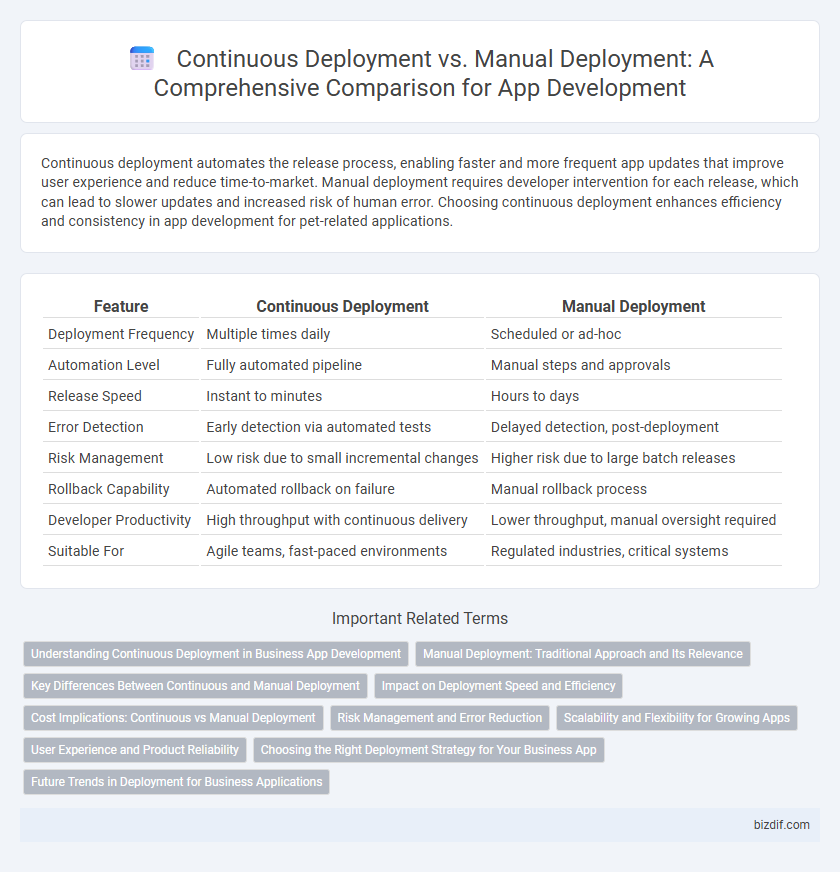Continuous deployment automates the release process, enabling faster and more frequent app updates that improve user experience and reduce time-to-market. Manual deployment requires developer intervention for each release, which can lead to slower updates and increased risk of human error. Choosing continuous deployment enhances efficiency and consistency in app development for pet-related applications.
Table of Comparison
| Feature | Continuous Deployment | Manual Deployment |
|---|---|---|
| Deployment Frequency | Multiple times daily | Scheduled or ad-hoc |
| Automation Level | Fully automated pipeline | Manual steps and approvals |
| Release Speed | Instant to minutes | Hours to days |
| Error Detection | Early detection via automated tests | Delayed detection, post-deployment |
| Risk Management | Low risk due to small incremental changes | Higher risk due to large batch releases |
| Rollback Capability | Automated rollback on failure | Manual rollback process |
| Developer Productivity | High throughput with continuous delivery | Lower throughput, manual oversight required |
| Suitable For | Agile teams, fast-paced environments | Regulated industries, critical systems |
Understanding Continuous Deployment in Business App Development
Continuous Deployment automates the release of business app updates, enabling faster delivery of features and bug fixes directly to users without manual intervention. This approach reduces deployment errors and accelerates the feedback loop, enhancing overall app reliability and customer satisfaction. By integrating Continuous Deployment, development teams maintain a streamlined workflow that supports rapid innovation and competitive advantage in the app market.
Manual Deployment: Traditional Approach and Its Relevance
Manual deployment remains a traditional approach in app development where developers or IT teams manually transfer code changes to production environments. This method provides granular control over the deployment process, allowing teams to carefully verify updates before release, which is crucial for applications requiring high-security or compliance standards. Despite the rise of continuous deployment, manual deployment retains relevance in scenarios with complex configurations and when minimizing automation risks is a priority.
Key Differences Between Continuous and Manual Deployment
Continuous deployment automates the release process by integrating code changes into production immediately after passing automated tests, enabling faster delivery and reduced human error. Manual deployment requires human intervention at each release stage, resulting in slower updates but offering more control and customization. Continuous deployment enhances development efficiency with rapid feedback loops, while manual deployment provides greater flexibility for complex or sensitive applications.
Impact on Deployment Speed and Efficiency
Continuous deployment automates the release process, significantly reducing deployment time and minimizing human errors, which enhances overall efficiency. Manual deployment requires developer intervention for each release, often resulting in slower rollouts and increased risk of mistakes. Leveraging continuous deployment pipelines accelerates delivery cycles, enabling faster feedback and more frequent updates in app development.
Cost Implications: Continuous vs Manual Deployment
Continuous deployment reduces long-term costs by automating testing and release processes, minimizing human error and deployment delays. Manual deployment requires more labor resources, increasing operational expenses due to frequent intervention and potential downtime. Choosing continuous deployment optimizes resource allocation, lowers maintenance costs, and accelerates time to market.
Risk Management and Error Reduction
Continuous Deployment significantly reduces deployment risks by automating the release process, ensuring that code changes are tested and deployed incrementally, which minimizes human error and accelerates feedback loops. Manual Deployment increases the likelihood of errors due to human intervention, complex manual steps, and inconsistent processes, thereby elevating the risk of downtime and critical failures. Implementing Continuous Deployment tools like Jenkins, GitLab CI/CD, or CircleCI enhances error detection and rollback capabilities, strengthening overall risk management in app development.
Scalability and Flexibility for Growing Apps
Continuous deployment enables scalable app development by automating releases, allowing rapid iteration and immediate delivery of new features to a growing user base. Manual deployment limits scalability due to slower release cycles and increased risk of human error, hindering flexibility in adapting to user demands. Automated pipelines support flexible rollbacks and environment-specific configurations, essential for maintaining performance and reliability as applications grow.
User Experience and Product Reliability
Continuous deployment enhances user experience by delivering faster updates and bug fixes, ensuring the product remains highly reliable and responsive to user feedback. Manual deployment often introduces delays and human errors, which can negatively affect both user satisfaction and overall product stability. Automated pipelines in continuous deployment reduce downtime and improve consistency, resulting in a more seamless and trustworthy app experience.
Choosing the Right Deployment Strategy for Your Business App
Continuous deployment accelerates delivery by automating releases, reducing errors through consistent, tested pipelines, and enabling rapid customer feedback integration. Manual deployment offers greater control, ideal for complex applications requiring detailed review and customization before updates reach users. Evaluating factors like application complexity, team expertise, and business objectives is essential for selecting the deployment strategy that balances speed, reliability, and control tailored to your business app's needs.
Future Trends in Deployment for Business Applications
Future trends in app development emphasize continuous deployment for business applications due to its ability to accelerate release cycles and improve software reliability. Automation through continuous integration and continuous delivery (CI/CD) pipelines enables rapid, error-free updates, reducing downtime and enhancing user experience. Manual deployment is increasingly being supplemented or replaced by AI-driven tools that optimize deployment workflows and predict potential issues before they impact production.
Continuous Deployment vs Manual Deployment Infographic

 bizdif.com
bizdif.com